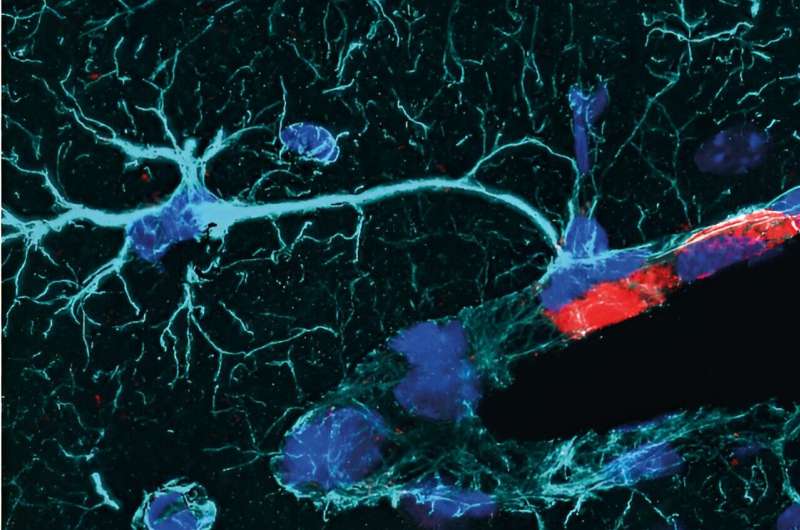July 26, 2024 feature
This article has been reviewed according to Science X's editorial process and policies. Editors have highlighted the following attributes while ensuring the content's credibility:
fact-checked
peer-reviewed publication
trusted source
proofread
Central nervous system-associated macrophages could modulate post-stroke immune responses

An ischemic stroke is a type of stroke that occurs when a blood clot in an artery, also known as thrombus, or the progressive narrowing of arteries, blocks the blood and oxygen flowing to the brain. This process can cause both temporary and permanent brain damage, for instance, leading to partial paralysis, cognitive impairments and other debilitating impairments.
Statistics suggest that older age increases the risk of experiencing ischemic strokes. While neuroscience studies have shed light on many of the physiological processes underpinning strokes, the immune responses following these events and promoting recovery remain poorly understood.
Researchers at the Institut Blood and Brain @ Caen-Normandie (BB@C), University of Edinburgh and other institutes in Europe carried out a study exploring how central nervous system (CNS)-associated macrophages (CAMs), immune cells residing at the CNS interfaces, contribute to post-stroke immune responses.
Their findings, published in Nature Neuroscience, suggest that during aging, CAMs coordinate the neuroimmune responses triggered by ischemic stroke.
"Central nervous system—associated macrophages (CAMs) are resident immune cells located at the interface between the blood circulation and the brain parenchyma. Under normal conditions, the role of CAMs is to monitor their environment, clean up debris, and signal the presence of pathogens to other immune cells," Marina Rubio, last author and coordinator of the study, told Medical Xpress.
"Their role after a stroke is still poorly understood, but due to their location, they could play a major role in modulating the inflammatory response to the stroke. In fact, they have been described as modulators of neutrophil infiltration and blood-brain barrier (BBB) integrity after stroke."
In one of their previous studies, the researchers found that CAMs modulate post-stroke inflammatory responses, particularly the neuroinflammatory priming induced by the excessive consumption of alcohol, which is known to be one of the many factors increasing the risk of strokes. Notably, a similar form of chronic, low-grade inflammation can also develop in aging adults.
This aging-related inflammation can contribute to the development and onset of numerous diseases, including ischemic strokes. Building on their previous findings, Dr. Rubio and her colleagues set out to test the hypothesis that the phenotype of CAMs could change during aging, which could in turn affect the inflammatory processes following ischemic stroke.
"To do this, we used a clinically-relevant thromboembolic stroke model consisting of the injection of thrombin directly into the middle cerebral artery in young and aged mice," Rubio said. "We used multimodal MRI techniques, in vivo two-photon microscopy, flow cytometry analyses and behavioral tests in mice. We also used human tissue samples to study the phenotype of CAMs in aged and control subjects."
In their experiments, the researchers also set out to explore the unique contribution of CAMs to the immune responses following strokes. To do this, they depleted CAMs by injecting liposomes containing a toxic substance into the cerebrospinal fluid (CSF) of the mice. In contact with this toxic substance, CAMs die by apoptosis.
"Our study provides the first evidence that CAMs acquire a phenotype during aging that can affect stroke-induced inflammatory responses and stroke recovery," Rubio said. "MHC II complex, overexpressed by CAMs during aging, partially modulates leukocyte infiltration and neurological outcome in aged mice after stroke. These findings highlight the potential of CAMs as a therapeutic target for stroke in the aged populations."
Overall, the findings gathered by Rubio and her colleagues suggest that CAMs are key coordinators of neuroimmune responses that promote the long-term fine-tuning of the immune processes that take place after a stroke.
In the future, these results could inform the development of more effective therapeutic interventions to promote the rehabilitation of individual patients after a stroke.
"The next research steps for our team will be to better understand the molecular mechanisms involved in the dialogue between CAMs and endothelial cells of cerebral blood vessels," Rubio added. "This could allow us to identify and develop new therapeutic targets for strokes aimed at modulating the cerebral immune response appropriately for each patient."
More information: Damien Levard et al, Central nervous system-associated macrophages modulate the immune response following stroke in aged mice, Nature Neuroscience (2024). DOI: 10.1038/s41593-024-01695-3.
© 2024 Science X Network




















